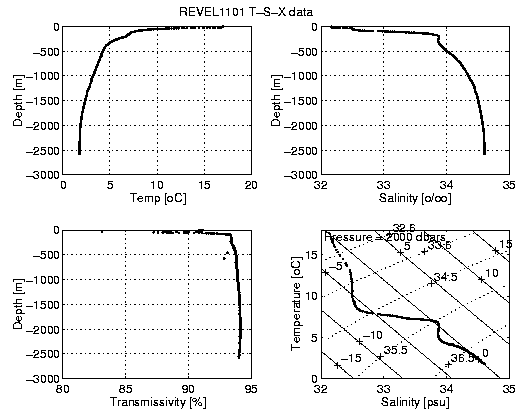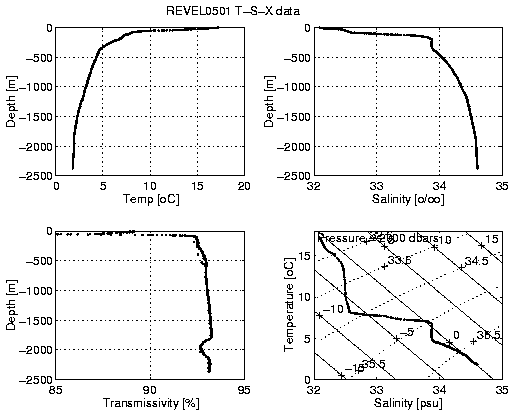

During the 1996 REVEL cruise 2 hydrocasts were conducted with the intention of measuring "background" depth profiles of temperature, salinity, and light transmissivity. Ideally, a background hydrocast reveals the nature of deep ocean water that has not been affected by hydrothermal venting; perturbations from the background conditions are interpretted as hydrothermally-contaminated water.
How do you tell if a cast has surveyed contaminated water? A simple test is to see if the clearness of the water has been decreased in the depth range where hydrothermal effluent is expected to equilibrate in the stratified deep ocean. REVEL cast 0501 shows evidence of occlusive particles between about 1900 and 2200 meters depth (see below). In contrast, REVEL cast 1101 and Mixing Zephyr cast 2v22 do not show any prominent decreases in the percent of light energy transmitted through the water at particular depths in the sea.
Light transmission can be decreased by non-hydrothermal processes -- like sediments being stirred up by turbulence or in bottom boundary layers, or biological activity. Similarly, light transmission ultimately returns to near-ambient levels as occlusive particles settle to the seafloor. Because a variety of processes can affect light transmission, it is important to monitor other parameters for coincident evidence of hydrothermal contamination.
Most deep ocean water masses have salinity and temperature relationships that do not change spatially (very much) over large areas. This is because... Indeed, in the Northeast Pacific, the deep (>1500 meters depth) water has nearly linear temperature and salinity depth profiles, and the slopes of the profiles do not differ (much?) over degrees of latitude and longitude (ref Emery and DeWar). Data from a series of stations in the NE Pacific reveal the following trends: (SIO?) What causes the linearity? (isopycnal subduction? turbulent diffusive mixing?) What about the slight curvature?
Buoyant hydrothermal plumes emanating from sources of variable temperature and salinity can significantly change the ocean's vertical profiles of salinity and temperature, causing deviations from linearity in the deep Northeast Pacific. Thus, contamination can also be observed by calculating how different a measured temperature and salinity are from the background conditions. This is best achieved by defining a new variable q=(Th-ThB)-(Thz/Sz)*(S-SB) where (...). Uncontaminated or background water will have q=0, whereas fluid with anomalous temperature or salinity will have positive or negative "q-ness." Of the 2 REVEL CTDT background casts, one appears to be uncontaminated when compared with the other:


